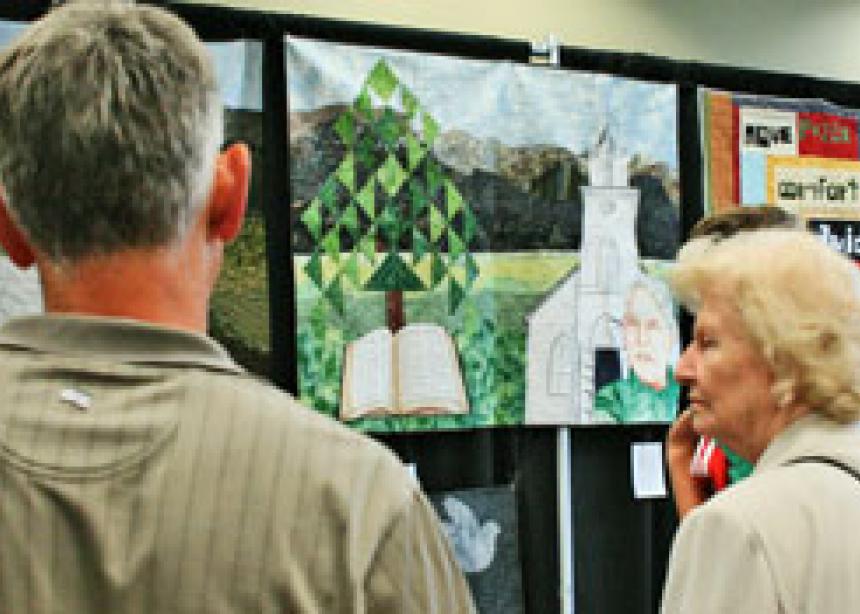For Bev Patkau, quilting is a labour of love, her fabric and thread a form of expression.
Patkau had several quilts on display at the Mennonite Church Canada assembly art exhibit, this year entitled Art for Peace. It’s an event that she has poured a great deal of energy into by helping Ray Dirks, curator of the Mennonite Heritage Centre Gallery in Winnipeg, Man., acquire and display quilts with a “peace” theme.
The quilt Patkau created specifically for the exhibit may seem to be of simple design, but those who study the careful stitching will discover quotes about peace embedded across the background. In other quilts, Patkau uses contrasting fabrics to create a sense of light and darkness, and symbols such as the dove and the cross.
A member of Foothills Mennonite Church, Calgary, Alta., Patkau uses her artistic gifts to prepare the sanctuary for holidays and special occasions throughout the year. The ability to share her work in this way is important to her; she feels that visual art is not widely accepted as a form of worship. Mennonite churches are often simply designed, with little visual enhancement, but she believes that art can enhance the worship experience.
“I think it nourishes the soul,” she says. “I see it the same as walking through beautiful scenery outdoors, and when we go inside, why do we have to stop seeing beauty?”
She notes that churches work hard to appeal to congregants’ auditory senses with music, but often offer little visual appeal. The inclusion of visual art provides another opportunity for worshippers to reflect and draw deeper into a prayerful connection with God, she believes.
Each of the quilts Petkau lovingly stitches are reminders of different episodes of her life. “I think that’s what quilting is,” she says. “A history of women’s lives. We make quilts for the major events in women’s lives—deaths, births, weddings—and we chronicle women’s history that way.”
Quilting as an art form has evolved from the practical craft of sewing covers for warmth. “Maybe that’s why we haven’t accepted it as an art form,” Patkau muses. “[But] even those traditional old quilts have beauty in them. The women who made them had very little in the way of material belongings, yet they managed to create beauty in their quilts.”
Patkau made her first quilt as a gift for her twin sister on her wedding day. “I was hooked,” she says. “I haven’t stopped quilting since. Probably about 15 years ago I started branching out and not just copying patterns, [and] getting more original. Over the last 10 years I’ve really started to go into artistic quilts, but I still do traditional quilts.”
Although she did not begin quilting until her adult years, Patkau says she has always kept busy with her hands, from crocheting and knitting to sewing and other crafts. “The art has to happen,” she says. “I have to create. It’s just part of what I have to do. I’m not happy if I’m not creating.”



Add new comment
Canadian Mennonite invites comments and encourages constructive discussion about our content. Actual full names (first and last) are required. Comments are moderated and may be edited. They will not appear online until approved and will be posted during business hours. Some comments may be reproduced in print.